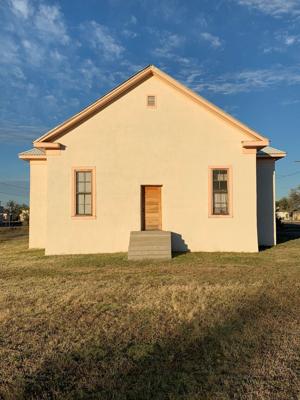The Blackwell School in Marfa, Texas, was the sole public education institution for the town's Hispanic students from 1909 to 1965. At first glance, it’s a rather unmarkable, plain-looking, one-story building that sits in an unadorned lot in the dry West Texas town of Marfa. It has off-white adobe walls and a metal roof.
On the front, it has two narrow vertical windows and a wooden door. A handful of utilitarian steps with no railings lead inside. And yet Blackwell School is the newest site in the U.

S. National Park system because of the remarkable story of what happened here. Secretary of the Interior Deb Haaland formally established the school as a National Historic Site on Wednesday, according to a news release from the National Park Service.
It’s one of 76 sites with that designation. It joins the ranks of such historically important places as the Eleanor Roosevelt National Historic Site in New York, the Ford’s Theatre National Historic Site in Washington, D.C.
, and the Tuskegee Airmen National Historic Site in Alabama. The National Park Service now has a total of 430 units , including 63 National Parks, under its wide umbrella. History of Blackwell School Built in 1909, the school “serves as a significant example of how racism and cultural disparity dominated education and social systems in the United States during this period of de facto segregation from 1889 to 1965,” the NPS release said.
Unlike schools in much of the South that primarily focused on segregation of African Americans, Blackwell was established for Mexican and Mexican-American students. By receiving the designation, Blackwell School has permanent protection and can provide physical testimony that helps tell the history of Texas school districts that set up elementary schools for Mexican American children, the release said. “A complete history of America must include everyone’s story.
The designation of the Blackwell School National Historic Site is an important step in telling a more diverse and inclusive history of the Mexican American experience in our country,” said Chuck Sams, director of the National Park Service. The site has the original 1909 adobe schoolhouse and a smaller 1927 classroom building known as the Band Hall. The buildings hold photographs, memorabilia and panels that display quotes and stories from students and teachers, NPS said.
Marfa: Tourist attraction Marfa, population just over 1,700, is about 45 miles east of the U.S.-Mexico border and about 400 miles west of San Antonio on a lonely stretch of high-altitude highway.
The town has become something of an essential stop for a West Texas road trip , especially for lovers of avant-garde art. Artist Donald Judd helped get things started in the 1970s with his installation of minimalist aluminum boxes inside buildings at the former Fort D.A.
Russell military post. It’s now called The Chinati Foundation (La Fundación Chinati) and features permanent, large-scale works of art. The town is also home to Prada Marfa, a stocked faux boutique by artist duo Elmgreen & Dragset that comments on materialism.
Various art galleries also dot the town, covering a range of styles from world tribal art to minimalist, contemporary works. Plan a trip Plan a visit to Blackwell School in Marfa by clicking here . Learn more here .
Seventy years after the Supreme Court outlawed separating public school children by race, a new report breathes life into an old question: How are the most coveted public schools able to legally exclude all but the most privileged families? In the first of its kind state-by-state breakdown by nonprofits Available to All and Bellwether Education , researchers unveil troubling laws, loopholes and trends that undermine the legacy of Brown v. Board, in which the supreme court ruled "separate educational facilities are inherently unequal" and violate the 14th Amendment. Public schools today are not required to explain or prove why they are denying a student enrollment, The 74 reports.
Paired with pressure to stack classrooms with "easier to educate" kids, school administrators say this leads to practices of denying Black, brown, low-income students and those with disabilities enrollment to public school, without consequence. The report argues discrimination has also been made widespread by allowing – and in four states, requiring – districts to use and enforce school attendance zones, which often mirror racist housing maps from the 1930s , separating children by home addresses. Schools contract with private investigators, prosecute or fine parents who defy zone lines via address sharing .
Only one state, Connecticut, has decriminalized the common practice. Researchers say the need to reform and undermine the weight home addresses have on educational outcomes is more urgent than ever, as many districts start to weigh closures and consolidations, leaving thousands of children, most often Black, brown and low-income students , hanging in the balance. "You can't be turned away from school because of your race, but if all of the Black people live on one side of the line, all the white people live on the other side of the line, it's OK to draw the line and assign kids to school based on that," said Tim DeRoche, coauthor of the report and founder of Available to All, a watchdog organization.
In the wake of Brown, courts took charge, taking on dozens of cases and stamping out explicit racial segregation, particularly in the South. "But they never came back around to fulfill that promise, that public schools had to be available to all in equal terms," DeRoche said. "There's all these other ways that we sort kids into schools that give advantages to people who have money or live in the right part of town.
The courts have just neglected to take that up and frankly, the legislatures have failed to take that up as well." The report makes the case for better legal protections, like requiring districts to operate open enrollment zones for families within a 3-mile radius, reserve seats for nonresidents, publish data on enrollment application and denials, and, when schools do reach capacity, require lotteries, common practice at public charter schools. It also provides a legal profile for each state, outlining their stance on laws that govern public school admissions .
In 36 states, for instance, families couldn't appeal their public school assignment even if they wanted to; Arkansas and California are among the few to explicitly protect the right to appeal to a neutral party. In Tampa , for example, a predominantly Black elementary school closed, its grade level reading proficiency rates at 11%. Instead of sending any of the few hundred students to the coveted school where 80% read at grade level minutes away from their homes, they were bused to poorer performing, majority minority schools further away, citing capacity constraints.
"When you see school closures, the politics comes out. You can see the exclusion very clearly," said DeRoche. Low-income students, students of color and those with disabilities are those most often excluded.
"Thereʼs this systemic pressure to sort of stack your school with kids who are easier to educate," said a former administrator cited in the report. Certain students — unhoused, migrant, incarcerated students or those with disabilities or in foster care — are supposed to be protected from enrollment discrimination by federal law, allowed to continue attending original schools in the event of moves. Still, the vast majority of decisions lay in the hands of administrators, whose admission practices fly under the radar, unrequired to publish data or provide written reasoning.
"In some states with strong open enrollment laws, such as Arizona and Wisconsin, districts are allowed to use unverified claims of capacity constraints to keep children with disabilities from enrolling," the report states. As one school psychologist with Los Angeles Unified described to The 74, "I've seen [zones] weaponized, too ..
. used more as a tool to get rid of students that are engaging in more problem behavior. 'Well, their address isn't even in our residence.
'" The school psychologist, speaking on condition of anonymity, witnessed kids get turned away about 15 times this school year. Some common reasons given to families — always verbally, never written — is that their school is full of capacity, can't accommodate the student's IEP, or, in one case, "we don't enroll in April." A few times, students were pushed out after mentioning moves offhand to teachers who said, "well, you cause too much havoc in my classroom.
So I'm gonna let somebody know." Some were able to stay because parents were "more assertive," in meetings with administrators, who then backed off. "A lot of the parents don't know their rights – some of them are just trying to survive so they don't have the time to go fight the district and be like, 'oh, my kid's not being enrolled.
' These families get taken advantage of more often." Such was the case in the four counties around Philadelphia, where a public radio investigation revealed the hundreds of kids kicked out of the districts each year for residency fraud were overwhelmingly low-income and Black . Pennsylvania does not have any law or process set for families who want to appeal admissions decisions.
But changing district attendance zone lines is no easy feat. In Chicago , parents flooded houses within the zone for sought-after Lincoln Elementary. When the district considered withdrawing boundary lines, parents were outraged and plans fizzled.
Ultimately the state allocated $20 million for the school to build an annex and add more seats, even though hundreds sat empty at schools in the neighborhood. "They're trying to protect these families who feel like, 'oh, I've already paid for my kids' school via my mortgage,'" said DeRoche. Available to All presents an alternative: Even if attendance zones were redrawn, other protections like laws to require 15% of seats be reserved for nonresident families or using a lottery once seats are filled, wouldn't force middle- or higher-income families out of quality schools they've invested in via housing.
Lines were not redrawn; Lincoln Elementary only became more accessible for the wealthy, predominantly white families who could afford to live in the attendance zone. "[Educational redlining] is a part of the fabric of our lives and we all kind of take it for granted. We're just trying to call it out and make people look at it straight in the face," DeRoche said.
Disclosure: Stand Together provides financial support to Available to All and The 74 . Andy Rotherham co-founded Bellwether Education Partners. He sits on The 74's board of directors.
This story was produced by The 74 and reviewed and distributed by Stacker Media. Need to get away? Start exploring magnificent places with our weekly travel newsletter..



















